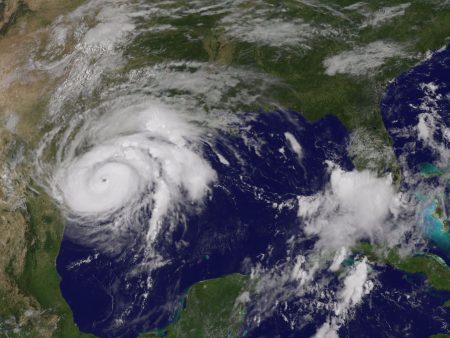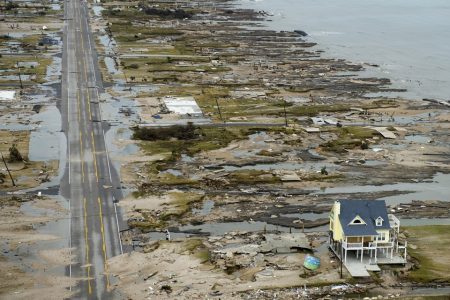August 25, 2017 – There is a hurricane off the Texas coast that will make landfall either today or early tomorrow morning. Called Hurricane Harvey, it is expected to grow to a Category 3 storm with winds of 179 kilometers (111 miles) per hour or higher. As it comes ashore the storm surge will produce coastal flooding. As well the storm is expected to drop up to 76 centimeters (30 inches) of rain on coastal areas of Texas as well as inland. These numbers are the kind that makes insurers very uncomfortable. But interestingly, the homes that lie in the path of Harvey are largely not insured against flooding because the cost to homeowners has been too high for most to afford coverage. Even in Houston where flood insurance purchases are highest, only 15% of homes have coverage.

This isn’t the first hurricane to strike the Texas coast. Back in September of 1900 before the existence of a comprehensive weather service in the United States, a Category 4 hurricane struck Galveston flooding the entire city which stood on average a mere 2.75 meters (9 feet) above sea level. That hurricane which happened before hurricanes were given names, unleashed a storm surge 4.5 meters high (15 feet). No one actually knows how many died that day because it was a Labour Day weekend. There was an ongoing fair which attracted out-of-towners. And because there was no accurate count of people in transit in and out of the city. At the time Galveston was the third largest port in the United States. The numbers between 6 and 8,000 represent the rough estimate of deaths. The damage to the city was permanent as Galveston soon became a minor seaport with Houston replacing it as the primary destination for ships on the Gulf of Mexico.
At the time of the Galveston hurricane, the military ran the weather service in America. Those assigned to local forecasting were soldiers who relied on no more than telegraph lines, cloud charts, readings from barometers and anemometers, and what they could see from their weather stations. Today the United States has a number of satellites in orbit dedicated to studying global weather. Hurricanes can be watched from conception to death. Storm tracks can be plotted with accuracy. Sophisticated weather simulators can compile data from thousands of on the ground and on the sea sensors that communicate up-to-date weather information at light speed. With all this technology it makes you wonder how Hurricane Katrina and Sandy could create so much devastation and that those lying in the path of these storms could be so ill prepared.
Insurance companies are more aware of extreme weather and climate change impacts than any governments on the planet today. That’s because they underwrite policies that are really like betting on the horses. The companies set premiums based on historic weather events and the modeling of potential future events. They don’t like to lose the money that homeowners pay in premiums for coverage. And when they get caught by a big payout the rates for coverage climb.
High insurance rates in flood, hurricane and tornado zones shouldn’t be a surprise. What on the other hand seems surprising is the number of homeowners who choose not to buy coverage. The house that represents the biggest life investment they will make during their lifetime, in most cases lies uninsured, or is uninsurable, because of location.
In the New Testament parable about a man who chooses to build a house on sand only to see it swept away by wind, rain, and flood, the lesson being taught is not really about extreme weather. But the parable should make those who read the bible equate its significance with the vulnerability of their own homes to unforeseen disasters and geography. The Gulf of Mexico and Atlantic Ocean coasts have always been hurricane landing zones. Tornado Alley has been around for as long as Americans have settled in the Mississippi-Missouri basin and the Great Plains. But many people living in these areas seem unaware of the ticking time bombs that surround them. On the other hand, the insurance companies, are very aware.
Going back to the 1990s the insurance industry has been conducting risk analysis related to extreme weather events and climate change. For the industry, the effects of climate change are seen in the broadest socioeconomic context. I have written in the past about reinsurers like Swiss Re and Munich Re who track natural disasters based on insurance losses. These companies note that between 1970 and 2004, out of the 15 most costly insurance losses, 12 were weather related. The other three involved earthquakes, a tsunami and 9/11.
The insurance companies are becoming increasingly aware that the money collected in homeowner premiums, and then reinvested, may end up buying shares in fossil fuel and energy utility companies whose carbon emissions in the atmosphere contribute to global climate change and an increasing frequency of extreme weather events, all leading to record claims and losses. Talk about a hamster wheel ready to roll off its base.
In a December 2016 column in The New York Times, Ron Lieber wrote about buying a home while considering climate change. He writes about “delusional thinking” as a common practice among American home buyers, particularly in light of “radical uncertainty.”
Lieber’s advice is:
- study the data
- study geography
- hire experts.
By experts, he doesn’t mean realtors. He’s talking about:
- municipal flood experts
- wind mitigation experts
- insurance experts and underwriters
- homedisclosure.com, a website that offers weather and environmental risk in your search area and includes sex offenders, meth labs and other nasty stuff.
Underwriters produce two reports that consumers can access: CLUE (the Comprehensive Loss Underwriting Exchange and A-PLUS.
And then there is always the FEMA website which provides environmental risk information by region and zip code.
Lieber concludes with the following: “Just how much more science and weather will it take before ever larger numbers of people decide to settle in or retire to places that pose less risk? And once they do, do you want to be trying to unload your property in a danger zone so you can afford to join them?”
My question to those seeking to buy proptery in flood prone zones: Is anybody listening to the experts these days under this current U.S. President?
If you watch HGTV and programs it airs such as “Beachfront Bargain Hunt,” you certainly have no sense of risk by people willing to purchase property within a couple of hundred meters of a rising ocean. And no one asks on these programs about flood risk even when a house has recently been propped up on stilts. But they do complain about a natural barrier such as a sand dune, or an area left in its natural state, blocking their view or making getting to the beach a little harder. They don’t recognize that dune or the naturalized space may be their only line of defense if there is a storm surge.
How bad can Hurricane Harvey get? The picture below is of the aftermath of Hurricane Ike after its landfall in an area near where Harvey will come ashore.



















The title of this article bugs me. Did Al Gore have a say so in the title? 🙂 Let’s just call the title ” Harvey to Make Landfall in Texas” or something better than the title that suggest Harvey is specifically due to humans as Al Gore preaches from his multi-million dollar mansion!
Hi George, No Al Gore in the picture. I chose this title because there are two forces at work here in the case of Hurricane Harvey. The first is the normal incidence of hurricanes at this time of year. But the second is the influence of higher than normal Gulf of Mexico temperatures that continue to spike upward. The Gulf is exhibiting a climate change, global warming infection. Now when you add a hurricane as slow moving as Harvey and pass it over warmer than normal water you get what Texas is seeing today. A storm that rapidly escalated from a Category 2 to 4 in a few hours before hitting landfall, and a storm so filled with moisture that it will be monsoon-like in areas of Texas for the next few days. There is enough rain in this storm to equal all the rain the state of Texas would normally receive over a year, all in 3 days.
Describing this just as another hurricane event, in my book, is not fully appreciative of the actual conditions. Hence I titled the piece with the words extreme weather and climate change to reflect the evidence of the latter and its contribution to the former.
Hi George, As I feared, Harvey is the “perfect storm” of climate change models. I didn’t write the script but sadly the conditions created by prolonged surface warming in the Gulf of Mexico have proven to be perfect feed stock for a Category 1 to become a Category 4 and then to compound it all by becoming a stationary low pressure cell over South Texas. Why stationary? Because of the abnormal behaviour of high atmospheric winds over North America, a continuing destabilizing phenomenon that is correlated to climate change. Stationary fronts have become more common in North America in the last two decades coincident with an abnormal Jet Stream pattern and a warming Arctic, both the consequences of a warming atmosphere.